I'm transcoding analog Video8 tapes recorded on a Sony V9 camcorder to DV for archival. The Sony V9 no longer works so I'm playing the tapes in a Sony TRV350 Digital 8 camcorder and transcoding as DV out via firewire to my DP Mac. This works ok except that I lose detail in the extreme highlights in the DV files compared to playback of the 8mm Video8 on the camcorder screen and on TV. I only seem to lose highlight detail when transcoding from analog Video8 tapes to DV. There doesn't seem to be any lose of highlight detail when transcoding from footage shot in Digital 8 format on the TVR350. It's not a 'levels' issue, as adjusting levels brightens or darkens the footage but does not bring back the clipped highlight detail. I've tried iMovie, Final Cut Express, and a couple of shareware capture programs all with the same result--a lose of highlight detail in the DV file. I know it's not the difference between computer display and TV display because I've converted the DV footage to MPEG4 and played it on my TV to compare to the analog Video8 tape played from the camcorder to the TV and there is a noticeable lose of highlight detail. I can also see the detail on the TRV350's color LCD as the tapes are playing and being transcoded so I know there is more highlight detail in the analog 8mm footage than what I'm getting in the DV.
Any thoughts as to what is causing this or how I might retain the original highlight detail?
Does analog 8mm have a wider dynamic range than DV?
Does transcoding to DV via firewire cause clipping of the dynamic range?
+ Reply to Thread
Results 1 to 30 of 32
-
-
I don't know iMovie or Final Cut Express, but many programs that work in RGB perform a contrast stretch on incoming YUV video to map IRE 0 to RGB 0 and IRE 100 to RGB 255. This loses all detail in areas below IRE 0 and above IRE 100 -- and DV camcorders often contain data above IRE 100. If you upload a few seconds of video with the problem I can verify whether the bright areas are clipped by the camcorder or by later handling in software.
-
Two things going on.
First, I've done extensive Video8 and Hi8 playback captures to DV using a Digital8 camcorder and levels are handled well. There should be no clipping in your DV format capture file.
Second issue consumer camcorders usually use 16-255 to fake more contrast rather than more correct 16-235 with only small overshoots into 235-255.
As Jagabo says, direct matrix of 16-235 to 0-255 RGB results in clipping above 235. Pro software usually use a "studio RGB" matrix that preserves the 236-255 information.
See this thread for examples. I haven't tested iMovie yet for 235 clipping but it looks like that is what is happening to you. I'll try to give it a test on my Mac this weekend.
https://forum.videohelp.com/topic329440.html?highlight=hi8%20235Recommends: Kiva.org - Loans that change lives.
http://www.kiva.org/about -
Ok, I've uploaded a couple seconds of analog Video8 transcoded to DV. I suspected something like you describe is happening, and the examples that edDV provided on the other thread look just like the amount of detail lost in my transcoded DV files. If Final Cut Express doesn't preserve the 236-255 information, is there any capture software that would on the Mac platform? Final Cut Express should be equivalent to the professional Final Cut Pro in this respect, only lacking some filters and effects. Maybe it's not possible to preserve the 236-255 information from a consumer camcorder on the Mac. If not, then I'll have to accept the small lose of detail as a trade-off to being able to save my deteriorating 8mm tapes as digital files.
clipped%20hl%20detail.dv -
Here's another attempt at uploading a sample clip. I changed the naming to be PC compatible.
clipped_hl.dv -
I'll try again. It is a 5MB quicktime file. This time I'll upload as a .zip file. If this doesn't work maybe someone can explain how to upload to this forum.
clipped_ht.dv.zip -
The 235-255 information is not there in the first place - by that I mean it is not in the DV video.
A waveform monitor can show this:
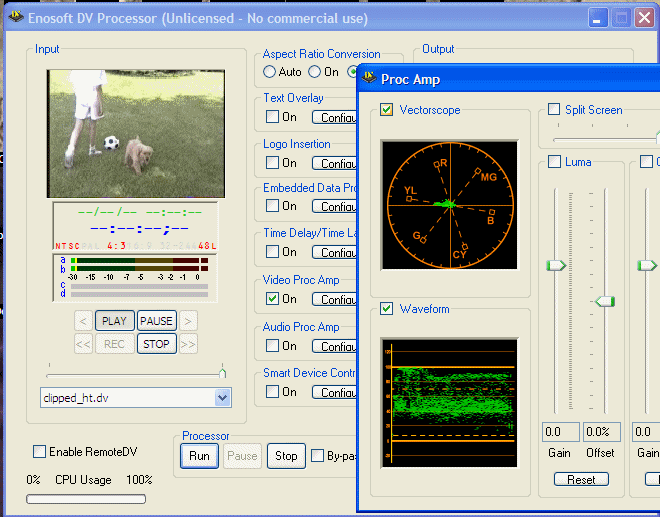
or with Vegas:
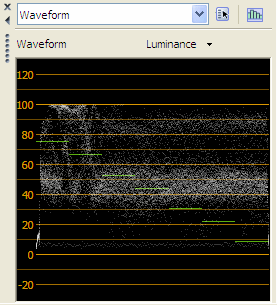
As you can see, the signal is clipping (hitting the 100 mark - the thicker orange lines). I can't speak for Vegas but in the case of our software (the first one), the information is displayed using exactly the information in the DV video as-is. There's no conversion to RGB, any deliberate clipping etc. So, it is certain that the Digital 8 camcorder has clipped the Video 8 during the encoding to DV.
Short of passing the Video 8 analog signal through an analog video amplifier to attenuate the signal, there isn't anything you can do. However, you can get such things quite cheaply. -
All my usual tools (under Windows) won't open a raw DV file. I just downloaded Enosoft DV Processor but it won't open the raw DV file either. It didn't have any problems with a normal DV AVI. So how do you get it to open the raw DV file?
-
Please add these to the registry (copy and paste as a .reg file then merge into the registry):
BTW, the current version is a preview of an upcoming release (which will have additional stuff) - so thank you for being an unwitting guinea pigCode:REGEDIT4 [HKEY_CLASSES_ROOT\Media Type\{73766169-0000-0010-8000-00AA00389B71}\{64737664-0000-0010-8000-00AA00389B71}] "0" = "0, 4, FFFFFF3F, 1F07003F" "Source Filter" = "{F865C08E-7D36-4266-AE06-51AABD80EBD0}" I'll update the server version tomorrow.
I'll update the server version tomorrow.
-
jagabo:
Donīt have Enosoft DV Processor installed. But Quicktime.
And this plays fine DV files, and Sony Vegas opens them also. (DV / DVCPRO codec says Vegas)
Gspot doesnīt find a codec, so itīs not a DirectShow thing, right?
Rest of the questions: Iīm out... -
That did it, Thanks.Originally Posted by JohnnyMalaria
I Used your software to convert dbx's raw DV file to a type 2 DV AVI file so I could use Avisynth to examine the data. I assume DV Processor simply remuxed the DV data into the AVI. I'm seeing something different than your post:
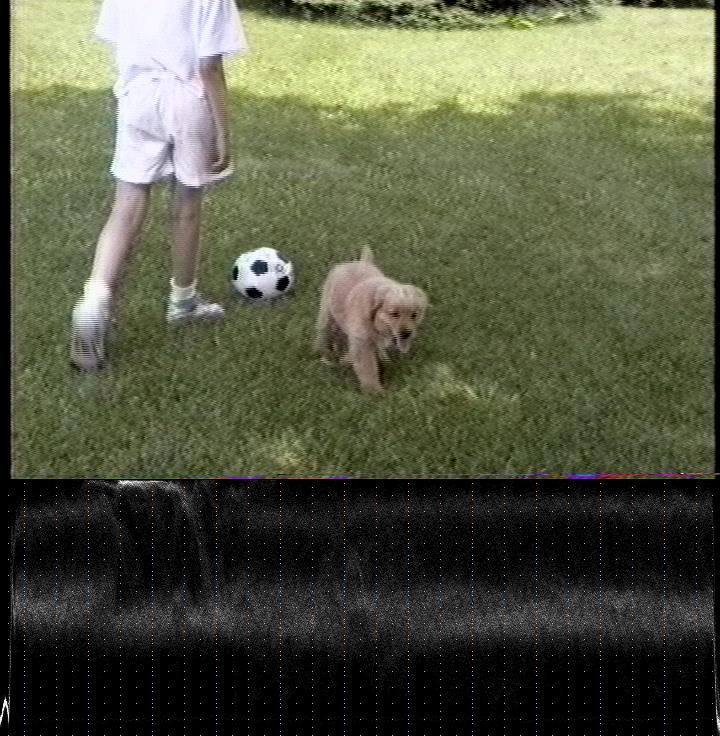
The bright areas are above IRE 100 (RGB 235). There is some clipping at the brightest sections but I was still able to bring out a little more detail by converting to RGB and retaining the luma levels.
By the way, I was able to open the raw DV file but I couldn't seem to get the wave form or vector graphs to show up in the Proc Amp dialog. -
When I opened it in Vegas, it too showed luma values above 235. I noted that the Vegas was decoding to Studio RGB. When I turned this off, the luma values were correctly scaled between 16 and 235.Originally Posted by jagabo
The scopes are active when the processor is actually processing something such as when converting a file or capturing from a camcorder.Originally Posted by jagabo -
Ah, got it.Originally Posted by JohnnyMalaria
The AviSynth VectorScope image was working on YUY2 right out of the DV decoder (Cedocida).Originally Posted by JohnnyMalaria
I ran another test with a Belle Nuit DV AVI file and got this with AviSynth:
Code:AVISource("bellenuit.avi") VideoScope() ConvertToRGB(matrix="pc.601") #to retain luma levels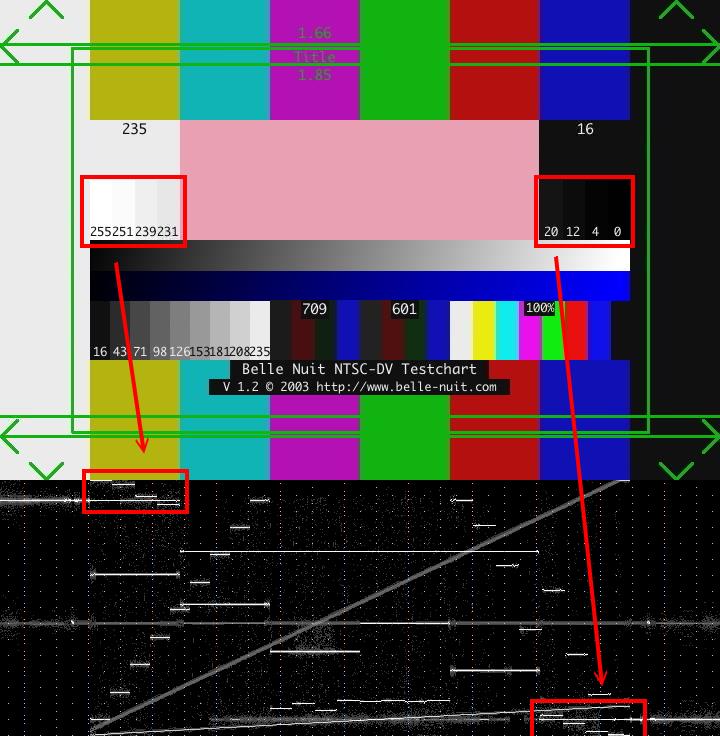
The VScope graph runs from Y=0 at the bottom to Y=255 at the top. You can see that there are luma samples with values all the way from 0 to 255 (note the red hilited boxes).
Running the same AVI file through Enosoft DV Converter shows nothing below the solid orange line at the bottom and nothing above the solid orange line at the top:
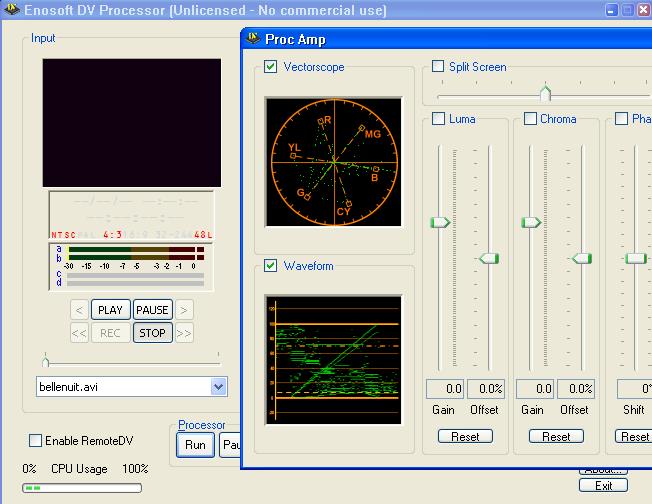
Those solid lines must therefore represent 0 to 255. I assume the dashed line isluma 16. Therefore the OP's DV file does have a lot of luma between 235 and 255. -
I'm not sure what's happening here.
Our waveform scope is generated without even decoding the DV frame. It simply uses the DC coefficients for the luma blocks (that's why the scopes are small - they are purposely designed this way for realtime color correction etc).
I shall investigate
-
Thanks guys, for analyzing my DV clip. I was starting to believe that my transcodes are just the way it is, that HL data from 235-255 gets clipped going from analog tape to DV within a consumer (TRV350) Digital 8 camcorder.
But, jagabo you've given me hope! Your image from my clip shows a remarkable improvement in HL detail. So, am I correct in assuming that the 235-255 information is still there in my DV files. Is it being clipped by the Mac's Quicktime translation of the camcorders DV-stream for capture in iMovie or Final Cut and ultimately being viewed via the Quicktime framework. As I said in my first post, when I convert one of these saved DV files to an MPEG4 file so I can view it on my TV from an iPod, the 235-255 info is still clipped and HL detail is gone. Would this be because of the Mac's Quicktime translation again?Originally Posted by JohnnyMalaria
Is there any possible way on the Mac platform to preserve the 235-255 information that jagabo recovered and be able to view it on computer or TV?Originally Posted by jagabo
Or, do you believe it only possible if I transfered my saved DV transcodes to the Windows platform? -
Have a look at this - what do you think?
clipped_ht_restored.zip
(If you need a .dv version, let me know)
jagabo - I'm eating my humble pie as I type(!) I forgot that there is an option to hard clip the waveform generator. I drilled into the raw DV frame and found that there are luma DC coefficients as high as 250. The Proc Amp function of the software works on the full range as can be seen in the "restored" clip.
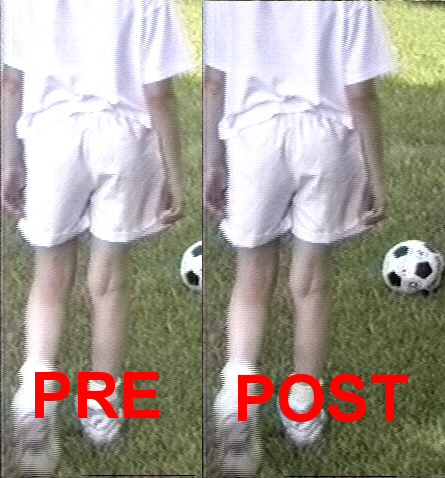
-
That looks awesome!
Your .avi file opens and views just fine in Quicktime on my Mac. And the fact that I can see the HL detail now in Quicktime shoots down my thought that Quicktime was causing the clipping. That actually is about the amount of detail that I see in the original Video8 tapes when played from camcorder to TV.
How'd you do that?
Is there a way I can do it on the Mac? -
Glad you like - I also improved the color:
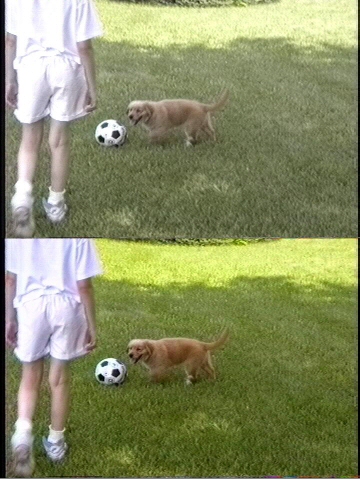
I'll post the method shortly (have to run an errand). -
I was able to get similar results using Vegas:
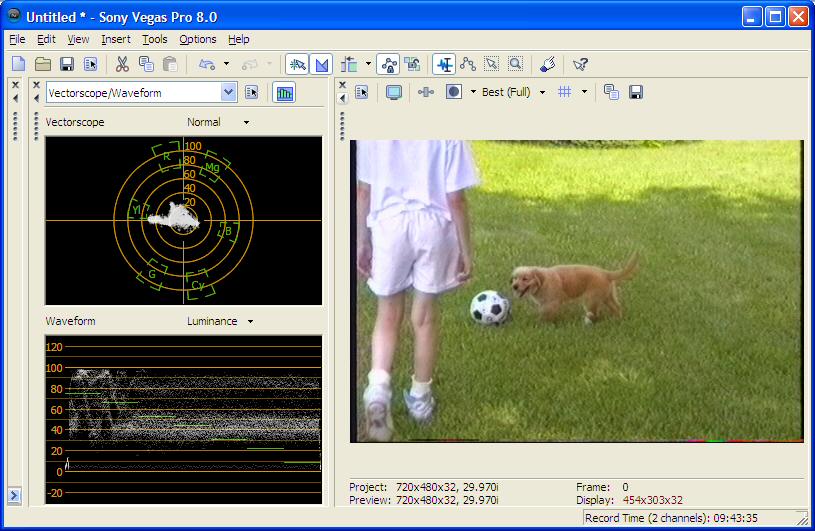
(I'm working on a laptop so I don't know how these look on a CRT display)
For Vegas and our software, the method was the same:
1. Reduce the brightness by about 8 - 10%
2. Increase the color saturation by about a factor of 2.
The exact figures will depend upon the software and how it represents the full range of brightness, color etc.
I'm not familiar with FCP nor iMovie so I cannot say how it would work on a Mac. -
I'm not convinced the Digital8 camcorder is at fault unless the TRV350 is different than earlier models.
I'm going to try iMovie tests soon, similar to what I did with Windows Movie Maker to see if iMovie is clipping.
Don't forget that software can also cause clipping.Recommends: Kiva.org - Loans that change lives.
http://www.kiva.org/about -
JohnnyMalaria, are you telling me that the HL detail in the range 235-255 is still in my saved DV files even thought it appears clipped when viewed on my Mac? Apparently, it appeared clipped on your PC as well, until you 'restored' it.
Any ideas why the detail appears gone if there is still information in the saved DV file?
Attempting to reduce the brightness in iMovie or Final Cut Express does not restore the detail in the 235-255 range. It simply pushes the clipped HL toward gray. -
Yes, the detail is still there. I'm able to look at the pure DV information numerically and there are definitely levels beyond 235 (the max was 250).
The problem is that DV isn't stored as red, green and blue (RGB) but luma and chroma (black/white and color, effectively).
Most (not all) video editing software works in RGB. Therefore, the DV has to be converted to RGB first. There are mathematic equations that do that. Unfortunately, there are different ones! With some of them, brightness levels above 235 in the native DV format end up more than 255 in the RGB world, which is not allowed. As a result, the RGB version of the video ends up clipping. A different set of equations doesn't do that.
I have no idea which iMovie or FCP use - or if there is an option to choose which (unlikely in iMovie but probable for FCP).
edDV will be able to shed some light on what iMovie does. -
JohnnyMalaria, then the brightness levels above 235 in the native DV format that end up more than 255 in the RGB world and is not being displayed on an RGB monitor is not specific to the Mac platform but can also be an issue on a PC with certain viewing software. So, my problem stems from the fact that the original Sony Video8 V9 camcorder recorded analog RGB information that is outside of the DV digital specifications--correct? If so, this is what I have been suspecting all along. Although, I was wrong in thinking that the Digital 8 camcorder was tossing out this information upon transcoding.
If there is no software that will transfer this information correctly to RGB on the Mac, would it work to copy my transcoded DV files to a network drive and open them on a PC with your software, restore the information to the viewable RGB range and save them again. Then they should open and play with all the HL detail on a Mac, PC, and TV--right? -
Originally Posted by dbx
It isn't about viewers or Mac vs PC or capture to an *.AVI or *.DV file.
It is about the matrix math used to convert DV format YCbCr to RGB. This is internal to the editing program.
We are talking about Hi8 to DV conversion here but the problem is the same for MPeg2, HDV, AVCHD and other MPeg4 camcorders.
Sorry for the delay but I have a full weekend of chores here. I'll try to test the Mac on the graveyard shift.Originally Posted by dbxRecommends: Kiva.org - Loans that change lives.
http://www.kiva.org/about -
Correct. And not just viewing software, also editing software.Originally Posted by dbx
No. Conventional video is recorded as luma and chroma, not RGB. Your Digital 8 camcorder is merely converting the analog luma and chroma voltages to digital information (plus it then compresses it but that isn't relevant here).Originally Posted by dbx
The DV spec permits values to go above 235 primarily to accommodate strong analog signals. However, DV equipment/software etc isn't required to support values outside of the 16 - 235. Thankfully, your camcorder does.
Based on the various tests by jagabo, edDV and myself, it is safe to say that your camcorder hasn't discarded any information. The problem lies with the conversion to RGB.Originally Posted by dbx
I'm afraid I don't know.Originally Posted by dbx
That should work. Our software can work with raw .dv files. Also, if you have additional videos to capture and a PC with FireWire, you can capture and adjust all at the same time.Originally Posted by dbx
John.
PS: For purely viewing purposes, it is very common for modern media players and graphics cards to use the luma/chroma directly without any need for RGB. I have no idea which software is needed for the Mac, though. -
dbx, just for your information:
Computers generally work in RGB where R=G=B=0 is the darkest black, and R=G=B=255 is brightest white. Digital video generally works in YUV where Y, the brightness component, usually ranges from 16 to 235. The darkest portions of the picture should be 16, the brightest portions should be 235. There should be very little in the frame below 16 or above 235. So most programs that convert from YUV to RGB stretch the 16-235 Y range to 0-255 RGB, and vice versa. -
Thanks for the explanations!
I understand now what is causing the clipping to occur. It's great to know that the Digital 8 camcorder is doing it's job, and my existing transcodes have the full information in them. Yes, I do have about 20 more 180 min. 8mm tapes to transcode. Unfortunately, I do not have a PC with firewire, only Dual Processor Mac workstations that I do PrePress and Graphic Imaging for offset printing with.
Hopefully, edDV can come up with a solution or a workaround on the Mac.
Thanks again, everyone, for your help! -
Preliminary observations.
First the good news. iMovie does not clip DV to 235 on import but some odd things are happening during DV export.
I shot out the window with my Canon HV20 in 4:3 DV format. This transferred into iMove fine and looks OK (but not as sharp) on the Mac monitor. I'm having difficulty finding the "Print to DV Tape" option in the iMovie Share menu. Best I could find was export to a Quicktime *.DV file. Unfortunately I can't import that back to Vegas until I buy Quicktime Pro . So for a quick test, I exported in iPod format 640x480 AAC-LC and imported that back into Vegas at the PC.
. So for a quick test, I exported in iPod format 640x480 AAC-LC and imported that back into Vegas at the PC.
Below the background is the camcorder DV picture and waveform. The foreground is a screen cap of the AAC import. You can see that the white sky extends up to 255 without clipping.
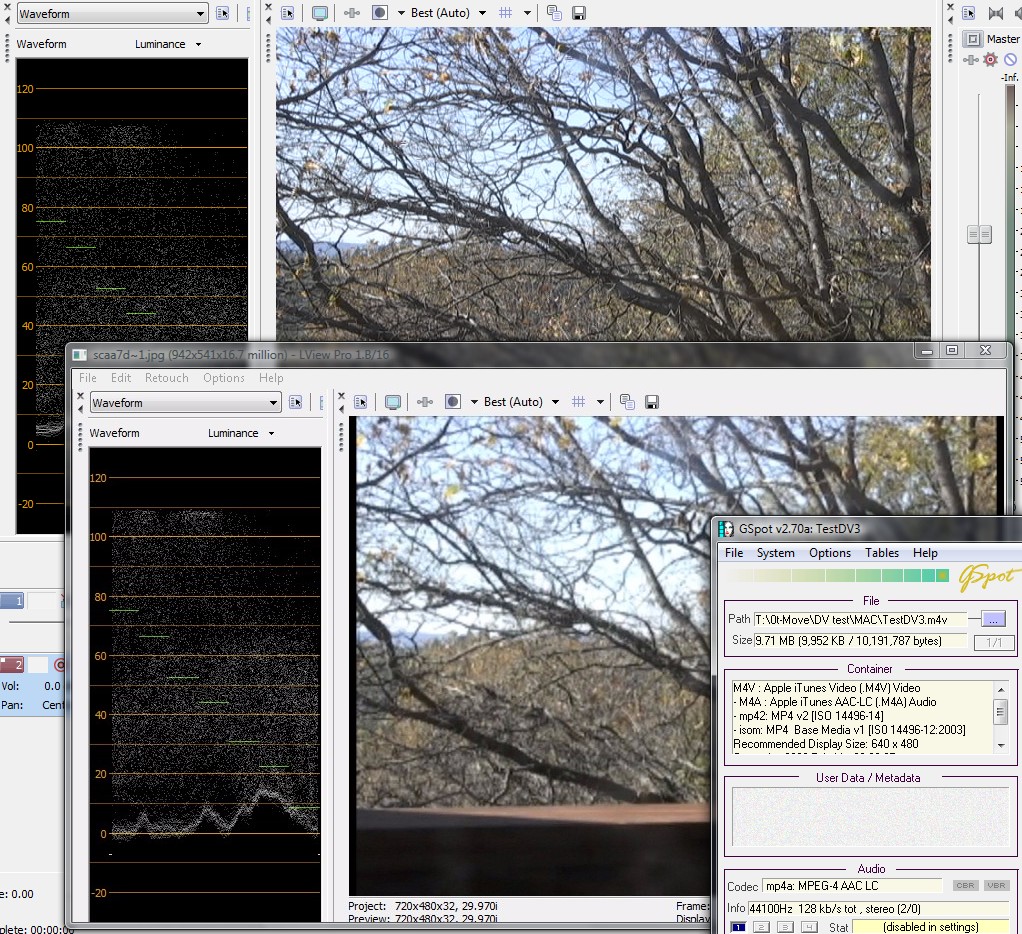
I'm stuck on iMovie DV export for now. The strange thing is when I play the *.DV in the Quicktime player, the picture looks washed out a bit on the Mac and washed out a lot on the PC Quicktime player. Anybody know what is happening here? I hope I can export DV back to tape and then capture back to Vegas for comparison.
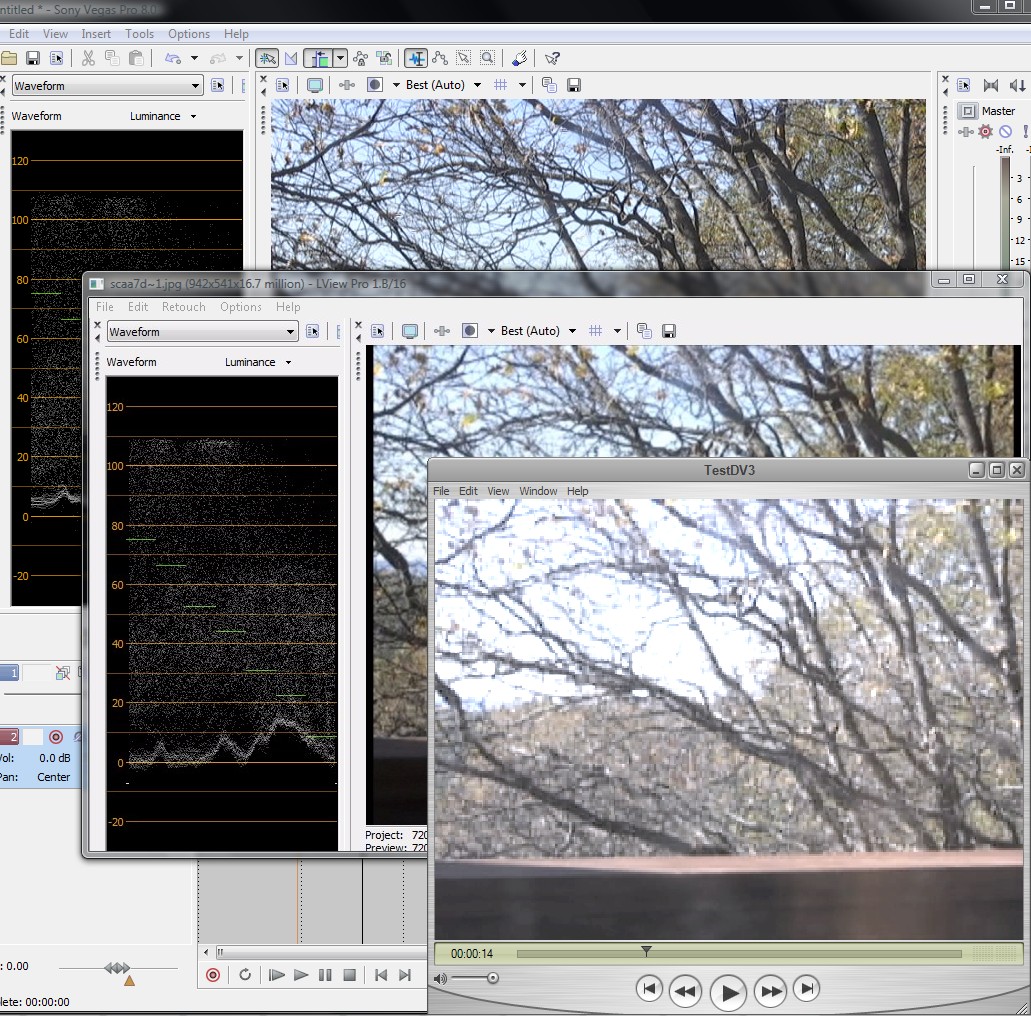 Recommends: Kiva.org - Loans that change lives.
Recommends: Kiva.org - Loans that change lives.
http://www.kiva.org/about
Similar Threads
-
What is best way to improve soft SD channel detail on LCD TV ?
By DBenz in forum DVB / IPTVReplies: 8Last Post: 28th Mar 2011, 12:23 -
improving dark skin detail
By BobAchgill in forum RestorationReplies: 14Last Post: 1st Jan 2009, 05:31 -
enhancing detail from video for a customer in trouble
By devdev in forum Newbie / General discussionsReplies: 1Last Post: 7th Jul 2008, 16:29 -
MPEG document describing 'open GOP' in detail?
By Alex_ander in forum Video ConversionReplies: 7Last Post: 9th Jun 2008, 14:49 -
Enhancing video detail/quality
By azinkin in forum Camcorders (DV/HDV/AVCHD/HD)Replies: 1Last Post: 14th Jun 2007, 09:16




 Quote
Quote